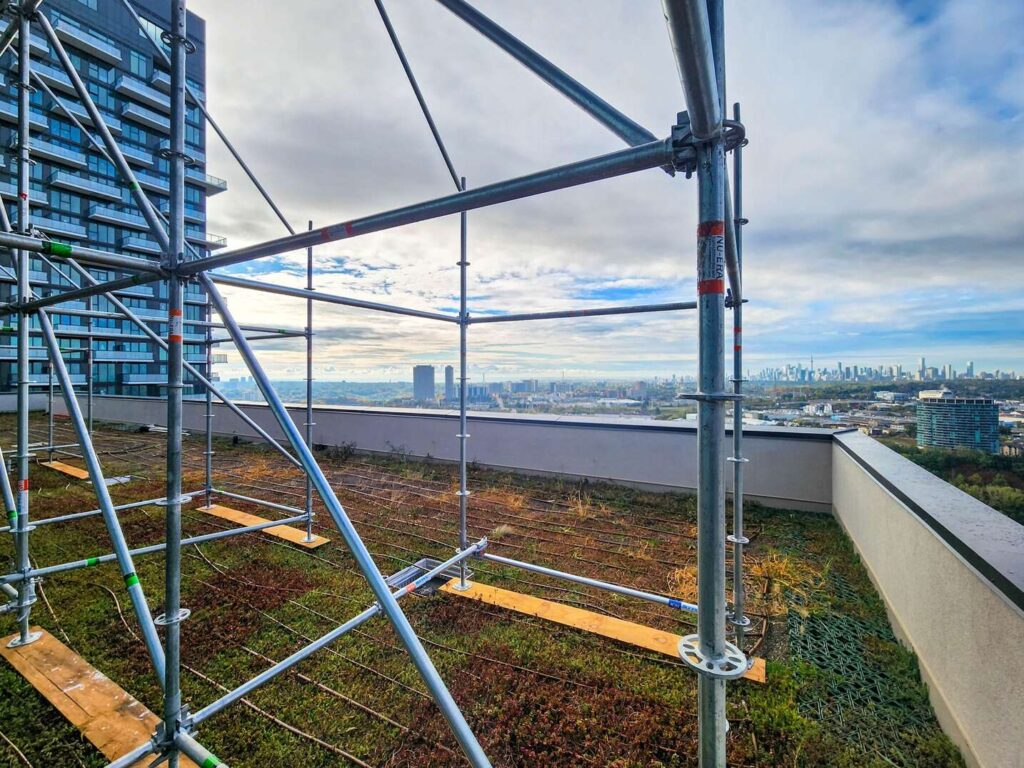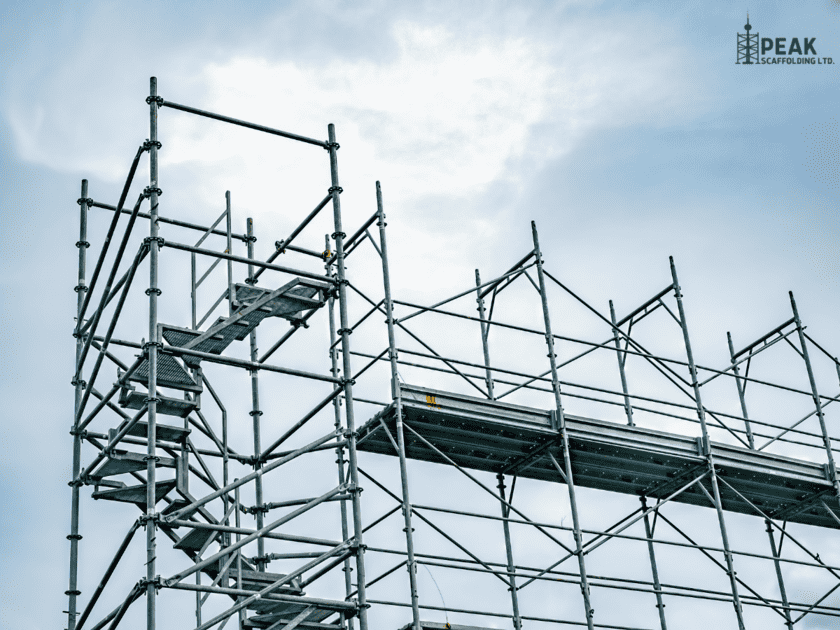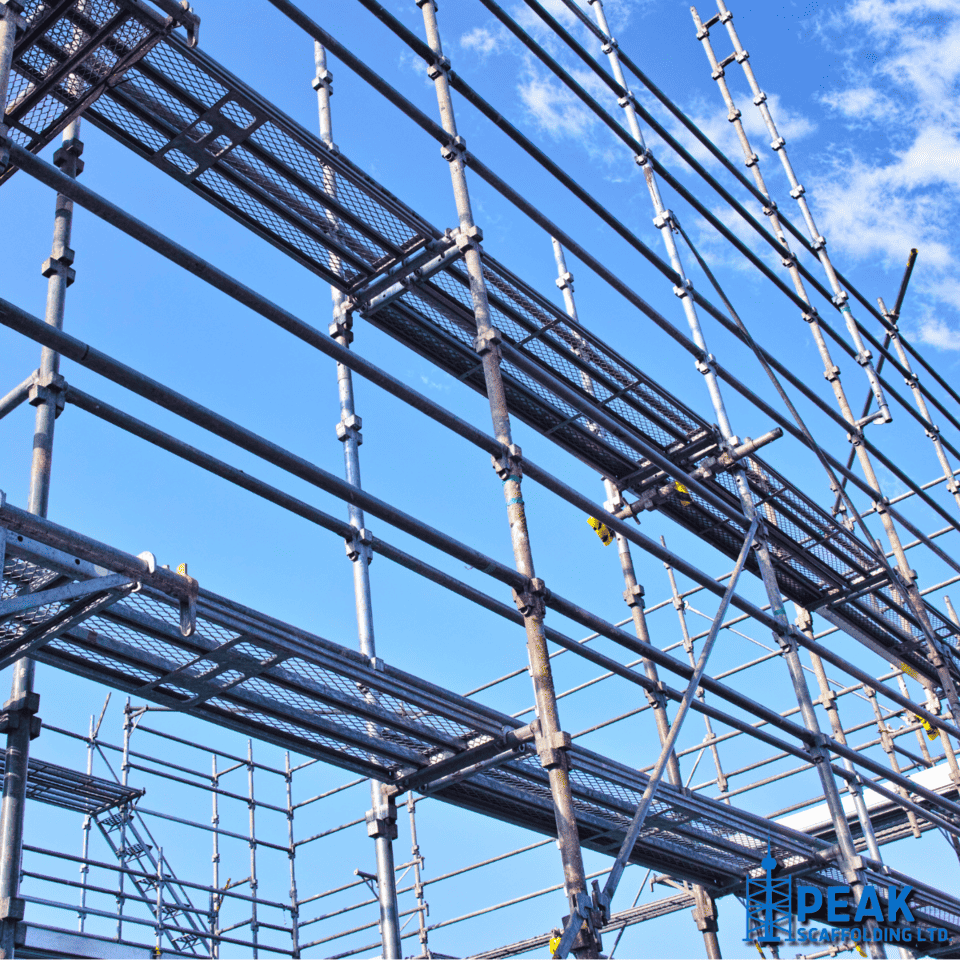Scaffolding is like a temporary high-rise on your construction site, providing workers with essential access to reach elevated areas. While undeniably useful, it also comes with its fair share of risks. Falls, falling objects, and even collapses are all too real dangers if proper precautions aren’t taken.
That’s where the golden rules of scaffolding come in. These aren’t just guidelines; they’re the fundamental principles that ensure safety and success on every scaffolding project. Let’s dive into each rule and see how they contribute to a secure working environment.

Rule 1: Proper Planning and Design: The Blueprint for Success
Never underestimate the importance of planning when it comes to scaffolding. Just like a building needs a solid blueprint, a scaffolding structure needs a well-thought-out design. This is especially true for complex projects involving multiple levels, unique structures, or challenging terrain.
Factors to Consider:
- Intended Use: What will the scaffolding be used for? Will workers be carrying heavy materials, using power tools, or performing delicate tasks? The design needs to accommodate these activities safely.
- Site-Specific Conditions: What are the ground conditions like? Are there any obstacles or hazards like overhead power lines? The scaffolding design needs to account for these variables.
- Applicable Regulations: Scaffolding must comply with all relevant safety regulations, including those outlined in the Ontario Occupational Health and Safety Act (OHSA) and any local building codes.
PEAK Scaffolding's Expertise
At PEAK Scaffolding, we understand that a well-designed scaffold is the foundation of a safe and successful project. Our team of experienced engineers and scaffolding experts can provide comprehensive design and engineering services, ensuring your scaffolding meets all safety requirements and is perfectly tailored to your project’s unique needs.
We take the guesswork out of scaffolding planning, providing you with a detailed blueprint for safe and efficient access solutions.
Rule 2: Quality Materials & Components: The Building Blocks of Safety
Think of scaffolding as a temporary building – its strength and stability depend entirely on the quality of its “building blocks,” the materials and components used in its construction. Cutting corners here can have disastrous consequences.
Scaffold-Grade Materials: Not Just Any Wood or Metal
It’s tempting to think that any scrap lumber or metal can be used for scaffolding, especially for smaller DIY projects. However, this is a dangerous misconception. Scaffolding materials need to meet specific standards for strength, durability, and resistance to the elements. Using subpar materials compromises the entire structure, putting workers at risk.
Always opt for “scaffold-grade” materials that are designed and tested for this specific purpose. These materials are engineered to withstand the loads and stresses of construction work, providing a reliable and safe platform for workers.
Regular Inspections: Spotting Trouble Early
Even with high-quality materials, wear and tear is inevitable. That’s why regular inspections of all scaffolding components are crucial. Look for signs of:
- Damage: Cracks, bends, or other deformities that could compromise structural integrity
- Corrosion: Rust or other forms of corrosion that can weaken metal components
- Loose Connections: Ensure all couplers, clamps, and fittings are tightly secured
- Wear and Tear: Check for signs of excessive wear on ropes, pulleys, or other moving parts
If any issues are identified, address them promptly. Never use damaged or compromised scaffolding components.
The Importance of Reputable Suppliers
Choosing a reputable scaffolding supplier is key to ensuring the quality of your materials. At PEAK Scaffolding, we source our materials from trusted manufacturers such as Layher who adhere to strict quality control standards. We also maintain a rigorous inspection and maintenance program for our rental equipment, ensuring that every component is in top condition and ready for safe use.
Avoiding Overload: Know Your Limits
Every scaffolding system has a maximum load capacity. Exceeding this limit puts immense stress on the structure, increasing the risk of collapse. Always be aware of the weight limitations of your scaffolding and avoid overloading it with materials, equipment, or personnel.
By prioritizing quality materials, regular inspections, and responsible load management, you’re laying a solid foundation for a safe and successful scaffolding project.
Rule 3: Expert Installation & Dismantling: Leave it to the Pros

Scaffolding might seem like a simple structure of poles and planks, but erecting and dismantling it safely requires specialized knowledge and skills. Attempting a DIY scaffolding installation can be a recipe for disaster, leading to instability, accidents, and potential legal repercussions.
Qualified Scaffolders: The Key to Safety
Entrust your scaffolding needs to qualified professionals who have undergone rigorous training and certification. These experts understand the intricacies of scaffolding construction, including:
- Proper Foundation: Ensuring the scaffold’s base is level, firm, and capable of supporting the intended load.
- Secure Anchoring: Attaching the scaffold to the building or other stable structures to prevent movement or collapse.
- Bracing and Stability: Installing diagonal braces and other supports to reinforce the structure and prevent lateral movement.
- Compliance with Regulations: Adhering to all relevant safety codes and guidelines to ensure a safe and legal setup.
Manufacturer's Instructions: Your Essential Guide
Every scaffolding system comes with detailed manufacturer’s instructions. These instructions outline the proper assembly procedures, load capacities, and safety precautions specific to that system. It’s essential to follow these instructions meticulously to ensure the scaffolding’s structural integrity and safety.
PEAK Scaffolding's Experienced Team
At PEAK Scaffolding, we have a team of experienced and certified scaffolders who are dedicated to providing safe and efficient installation and dismantling services. We follow industry best practices and adhere to all regulations, ensuring your scaffolding is erected and dismantled with precision and care.
Our team’s expertise extends to a variety of scaffolding systems, including Ringlock and Tube & Clamp. We can handle projects of any size or complexity, from simple residential setups to large-scale commercial installations.
By entrusting your scaffolding needs to PEAK Scaffolding, you’re not just getting a service; you’re gaining a partner committed to safety, quality, and the success of your project.
Rule 4: Ongoing Inspections & Maintenance: Keeping Your Scaffold Safe

A scaffolding structure, like any piece of equipment, is subject to wear and tear. Even with the best initial setup, things can change over time. That’s why regular inspections and maintenance are non-negotiable. It’s about catching small problems before they turn into big accidents.
The Inspection Schedule
There are three main times when a scaffold must be inspected by a competent person:
- Before Each Use: This is a quick visual check to spot any obvious damage or hazards before workers get on the scaffold.
- After Any Alterations: If you change the scaffolding’s setup, add or remove parts, it needs to be re-inspected to make sure it’s still safe.
- Regularly: Depending on the type of scaffold and how it’s being used, regular inspections are also required. This is usually weekly or monthly.
What to Look For During Inspections
Inspections should be thorough, covering all aspects of the scaffold’s structure and safety features. Look for:
- Damage to Components: Cracks, bends, rust, or any other signs of wear and tear.
- Loose Connections: Check that all couplers, clamps, and fittings are tight and secure.
- Stability Issues: Is the scaffold level and plumb? Are there any signs of movement or shifting?
- Fall Protection: Ensure guardrails, mid-rails, and toe boards are in place and in good condition.
- Access Points: Check that ladders and stairways are secure and in good working order.
- Environmental Hazards: Look for any potential hazards caused by weather or site conditions, such as ice buildup or falling debris.
Act Quickly on Any Issues
If any problems are found during an inspection, they need to be fixed right away. Never let workers use scaffolding that’s damaged or unstable.
Rule 5: Fall Protection is Paramount: Preventing the Unthinkable
Falls from heights remain one of the most significant risks in the construction industry. Scaffolding, by its very nature, exposes workers to this danger. Therefore, prioritizing fall protection is absolutely crucial.
Guardrails: The First Line of Defense
Guardrails, mid-rails, and toe boards form the primary barrier against falls from scaffolding platforms. They should be installed on all open sides and ends of the scaffold, creating a physical barrier to prevent workers from falling off the edge.
Key points about guardrails:
- Height Requirements: Regulations specify minimum heights for top rails, mid-rails, and toe boards to ensure adequate protection.
- Secure Installation: Guardrails must be securely attached to the scaffold structure and able to withstand anticipated loads.
- Regular Inspections: Inspect guardrails before each use and after any modifications to ensure they are in good condition and properly installed.
Harness and Lanyard Systems: When Guardrails Aren't Enough
In situations where guardrails aren’t feasible or provide insufficient protection, personal fall arrest systems are essential. These systems typically include:
- Full Body Harness: A harness worn by the worker that distributes fall forces across the body, reducing the risk of injury.
- Lanyard: A connecting device that attaches the harness to a secure anchor point on the scaffold.
- Self-Retracting Lifeline: A device that automatically retracts and locks in the event of a fall, limiting the distance of the fall and arresting the worker’s descent.
Access and Ladder Safety
Safe access to and from the scaffolding platform is crucial. This includes:
- Secure Ladders: Ladders should be securely attached to the scaffold and extend at least one meter above the landing platform.
- Stair Towers: For taller scaffolds, stair towers may be required to provide safe and convenient access.
Training and Awareness
Fall protection is only effective if workers are properly trained in its use. All workers on scaffolding should receive comprehensive training on:
- Fall hazards and prevention: Recognizing potential fall risks and implementing safety measures.
- Proper use of fall protection equipment: How to wear, inspect, and use harnesses, lanyards, and other fall protection devices correctly.
- Emergency procedures: What to do in case of a fall or other emergency.
By prioritizing fall protection and ensuring that workers are well-trained and equipped, you can significantly reduce the risk of falls and create a safer working environment on your scaffolding project. Remember, every worker deserves to return home safely at the end of the day.
Rule 6: Respect the Environment & Surroundings: Building Responsibly

Construction sites, even temporary ones, can have a significant impact on the surrounding environment. As responsible builders, it’s crucial to minimize this impact and respect the communities where we work. Let’s explore how scaffolding can play a role in environmentally conscious construction practices.
Containment is Key
Falling debris is not only a safety hazard for workers and pedestrians but can also cause damage to property and the environment. Implementing proper containment measures is crucial:
- Debris Netting: Install secure netting around the scaffolding to catch any falling objects, preventing them from reaching the ground or harming passersby.
- Tarps & Sheeting: Use tarps or sheeting to enclose work areas and prevent dust and debris from spreading. This is particularly important in urban areas where construction sites are often close to businesses and residences.
Minimizing Noise and Dust Pollution
Construction noise and dust can be a nuisance for nearby communities. Taking steps to mitigate these impacts is essential for maintaining good relations with your neighbours and protecting the environment.
- Noise Barriers: Erect temporary noise barriers around the construction site to dampen sound and minimize disruption to the surrounding area.
- Dust Suppression: Employ dust suppression techniques, such as water misting or using vacuums with HEPA filters, to control dust and prevent air pollution.
- Scheduling: Schedule noisy work during appropriate hours to avoid disturbing residents during early mornings or late evenings.
Sustainable Scaffolding Practices
The scaffolding industry is increasingly embracing sustainability, seeking ways to reduce its environmental impact. Here are some eco-friendly practices to consider:
- Recycled and Recyclable Materials: Opt for scaffolding systems made from recycled materials or those that can be easily recycled at the end of their life cycle.
- Efficient Transportation and Storage: Choose modular scaffolding systems that can be compactly stored and transported, reducing fuel consumption and emissions.
- Minimal Waste: Minimize material waste by using prefabricated components and avoiding unnecessary cutting or modifications.
PEAK Scaffolding's Green Commitment
At PEAK Scaffolding, we recognize the importance of responsible construction practices. We prioritize sustainability in our operations and strive to minimize the environmental impact of our scaffolding solutions.
- Recycling and Reuse: We actively recycle and reuse materials whenever possible, reducing waste and conserving resources.
- Efficient Logistics: We optimize our transportation and storage practices to reduce fuel consumption and emissions.
- Sustainable Partnerships: We work with suppliers who share our commitment to sustainability, sourcing eco-friendly materials and components whenever possible.
By choosing PEAK Scaffolding, you’re not only getting a safe and reliable scaffolding solution but also partnering with a company that values environmental responsibility and contributes to a greener Toronto.
Rule 7: Communication & Teamwork: Building a Culture of Safety
Scaffolding isn’t a solo act; it’s a collaborative effort involving multiple parties, from the scaffolding provider and construction crew to site supervisors, engineers, and even nearby residents and businesses. Effective communication and teamwork are essential for ensuring everyone is on the same page and prioritizing safety.
Clear Communication: The Foundation of Collaboration
Open and transparent communication is crucial throughout the entire scaffolding process, from planning and design to installation, use, and dismantling. Here are some key aspects:
- Scaffolding Provider: Clearly communicate your project needs, expectations, and any specific safety concerns to your scaffolding provider.
- Construction Crew: Ensure workers understand the scaffolding’s limitations, safety protocols, and emergency procedures.
- Site Supervisors: Supervisors should actively oversee scaffolding operations, ensuring workers follow safety guidelines and addressing any concerns promptly.
- Engineers: If your project requires complex scaffolding designs or modifications, maintain open communication with the engineers involved to ensure structural integrity and compliance.
- Stakeholders: Keep nearby businesses and residents informed about the project timeline, potential disruptions, and contact information for addressing any concerns.
Regular Toolbox Talks and Safety Meetings
Schedule regular toolbox talks and safety meetings to discuss scaffolding-related safety topics, reinforce best practices, and address any questions or concerns from the team. These meetings provide an opportunity for open dialogue and promote a culture of safety on the construction site.
Reporting Hazards: Don't Stay Silent
Encourage workers to report any hazards or concerns they observe regarding the scaffolding, no matter how minor they may seem. Addressing potential issues early can prevent accidents and ensure the continued safety of everyone on site.
Fostering a Culture of Safety
Beyond just following rules and procedures, fostering a culture of safety is essential. This involves:
- Leadership Commitment: Management should demonstrate a strong commitment to safety, setting an example for the entire team.
- Empowerment: Encourage workers to take ownership of their safety and speak up if they see something unsafe.
- Continuous Learning: Provide ongoing safety training and education to keep workers informed and engaged.
- Recognition: Acknowledge and reward safe behaviours and practices to reinforce positive safety habits.
By prioritizing communication, teamwork, and a proactive approach to safety, you can create a work environment where everyone feels empowered to contribute to a safe and successful scaffolding project.
FAQs About Scaffolding Golden Rules
Let’s delve into some common questions and concerns surrounding the golden rules of scaffolding:
While the core principles of scaffolding safety are generally consistent, specific regulations and guidelines can vary depending on your location. In Toronto, it’s crucial to comply with both provincial regulations (like the Occupational Health and Safety Act) and municipal codes (like the Toronto Building Code). Always consult local authorities or a scaffolding expert to ensure your project adheres to all applicable rules.
The consequences of neglecting scaffolding safety can be severe, including:
- Accidents and Injuries: Falls, falling objects, and scaffold collapses can lead to serious injuries or fatalities.
- Legal Repercussions: Non-compliance with safety regulations can result in fines, lawsuits, and even criminal charges.
- Project Delays and Financial Losses: Accidents and safety violations can cause costly project delays and damage your reputation.
Partnering with a reputable scaffolding company like PEAK Scaffolding is the best way to ensure your project is safe and compliant. We have the expertise, experience, and commitment to safety to guide you through every step of the process, from design and planning to installation, maintenance, and dismantling.
No project is too big for PEAK Scaffolding. We specialize in custom scaffolding solutions tailored to your specific needs and challenges. Our team of experts can handle everything from simple residential setups to complex industrial projects, ensuring safety and compliance every step of the way.
Creating a culture of safety goes beyond just following rules. It involves:
- Leadership Commitment: Management must demonstrate a strong commitment to safety, setting an example for the entire team.
- Open Communication: Encourage workers to speak up about safety concerns without fear of reprisal.
- Regular Training: Provide ongoing safety training and education to keep workers informed and engaged.
- Recognition and Rewards: Acknowledge and reward safe behaviours and practices to reinforce a positive safety culture.
By prioritizing safety and fostering a collaborative environment, you can create a worksite where everyone feels empowered to contribute to a safe and successful project.
Conclusion: The Golden Rules of Scaffolding: Your Path to a Safe and Successful Project
Scaffolding, while essential for construction projects, demands respect and adherence to safety principles. The golden rules we’ve explored serve as a guiding light, illuminating the path to a secure working environment.
Remember, prioritizing safety isn’t just about compliance – it’s about protecting lives and ensuring the success of your project. By embracing these golden rules, you’re fostering a culture of responsibility and vigilance that benefits everyone involved.
At PEAK Scaffolding, safety isn’t just a priority, it’s at the core of our values. We’re dedicated to providing expert guidance, top-quality equipment, and meticulous installation to ensure your scaffolding projects meet the highest safety standards.
Don’t gamble with safety. Contact PEAK Scaffolding today and let us be your partner in building a safer, more productive future.

